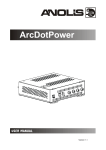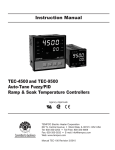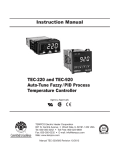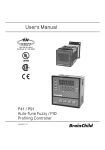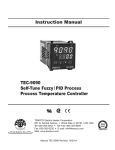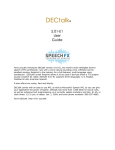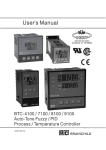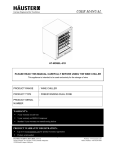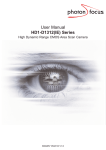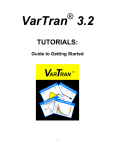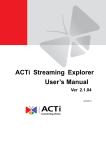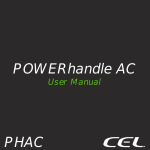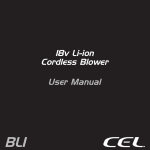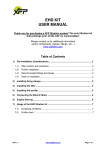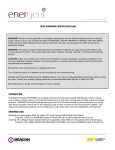Download TPC Type 1 Self-Powered Output
Transcript
Visionary Solutions for Industry ® Temperature Controllers & Sensors ◆ ® Since 1972 — Heating Elements ◆ ISO 9001 Certified Process Heating Systems ® Instructions for TPC Power Through Control Console SPECIFICATIONS Temperature Controller: Model TEC-9100, 1/16 DIN Dual Display with PID Auto-tuning Sensor Input: Type “J” or type “K” thermocouple dependent on model ordered (Alternative inputs available for special order) Power Cord/voltage Input: 120VAC or 240VAC (dependent on model ordered) Heater Output: 8A max for 1-zone consoles 4A max per zone for 2-zone consoles 2.7A max per zone for 3-zone consoles 2A max per zone for 4-zone consoles Output Device: Solid State Relay Main Power Switch: Located on front panel Fuse Main Power: See replacement parts list (located inside power inlet module) Fuse Control Power: See replacement parts list (located on back panel) WARNINGS 1. Air vents located on top and bottom of console must not be blocked! To prevent an overheating condition the internal components must remain as close to room temperature (75ºF / 24ºC) as possible. 2. Dangerous voltage capable of causing injury or death is present within this console. Power to all equipment must be disconnected before installation or beginning any troubleshooting procedures. Heater output wiring and component replacement must be made by qualified personnel only. 3. To minimize the possibility of fire or shock, do not expose this console to rain or excessive moisture. 4. Do not use this console in areas where hazardous conditions exist such as excessive shock, vibration, dirt, corrosive gases, oil or where explosive gases or vapors are present. WIRING (For safety, disconnect all power sources prior to wiring) 1. Attach the leads from your type thermocouple to the mini-plug provided. Take care to note the correct polarity. The red lead is (-) negative. 2. The heater output current is sourced directly thru the line cord. The rear console output receptacle and mating Hubbell plug provides live controlled power for direct connection to your heater(s). Connect one lead from your heater to one prong of the Hubbell plug (not ground). Connect the other lead from your heater to the other prong. Connect heater ground (if applicable) to the ground connection (G) on the plug. © 2015 Tempco Electric Heater Corporation (Revision 8/12/2015) TEMPCO Electric Heater Corporation 607 N. Central Avenue ◆ Wood Dale, IL 60191-1452 USA ◆ 630.350.2252 ◆ Fax: 630.350.0232 E-mail: [email protected] ◆ Web: www.tempco.com Page 1 of 12 OPERATION 1. Verify the power switch is in the off position. Plug your heater & thermocouple into the rear connectors. Plug the provided line cord from the console into a standard outlet. Switch on the console. 2. Set your desired temperature setpoint by using the up and down arrow buttons on the TEC-9100 temperature controller. 3. Refer to the following pages for complete operation and auto-tuning of the TEC-9100 temperature controller. SPARE/REPLACEMENT PARTS Tempco Part Number Description EHD-124-184 Fuse(s), rated 10 Amps/ 250V, 5 x 20mm fast acting, BUSS S500-10-R. Used for main and heater (power located inside power cord inlet). EHD-124-137 (for 1, 2, and 3-zone units) Fuse (1), rated 1 Amp/ 250V, ¼" x 1¼", fast acting, BUSS AGC-1. Used for TEC-9100 Controller (located inside rear panel mounted fuseholder) EHD-124-177 (for 4-zone units) Fuse (1), rated 1 Amp/ 250V, ¼" x 1¼", slow acting, BUSS MDL-1. Used for TEC-9100 Controller (located inside rear panel mounted fuseholder) EHD-124-168 (for 2-zone units) Fuses (2), rated 5 amps, 250V, ¼" x 1¼", fast acting, BUSS AGC-5 EHD-124-175 (for 3-zone units) Fuses (3), rated 4A, 250V, ¼" x 1¼", fast acting, BUSS AGC-4 EHD-124-186 (for 4-zone units) Fuses (4), rated 2.5 amps, 250V, ¼" x 1¼", fast acting, BUSS AGC-2.5 EHD-102-113 (for 120V units) Power output plug (1 per zone), Hubbell HBL4720C, 15A 125V Twist-Lock EHD-102-121 (for 240V units) Power output plug (1 per zone), Hubbell HBL4570C, 15A 250V Twist-Lock (Type of thermocouple plug dependent on console model ordered) TCA-101-104 Type “K” thermocouple mini plug (1 per zone), yellow TCA-101-105 Type “J” thermocouple mini plug (1 per zone), black NOTE: For all fuses, use listed BUSS part numbers or equal. Page 2 of 12 Chapter 1 Overview Tempco’s TEC-x100 Series Fuzzy Logic plus PID microprocessor-based controllers incorporate two bright easy to read 4-digit LED displays, indicating process value and set point value. The process value (PV) display is always the top digital display. The setpoint (SV) display is always the bottom display. Fuzzy Logic technology enables a process to reach a predetermined set point in the shortest time with a minimum of overshoot during powerup or external load disturbance. TEC-9100 is a 1/16 DIN size panel mount controller. TEC-7100 is a 72×72 DIN size panel mount controller. TEC-8100 is a 1/8 DIN size panel mount controller and TEC-4100 is a 1/4 DIN size panel mount controller. These units are powered by 11–26 or 90– 250 VDC/VAC 50/60 Hz supply, incorporating a 2 amp control relay output as standard. The second output can be used as a cooling control or an alarm. Both outputs can select triac, 5V logic output, linear current, or linear voltage to drive an external device. There are six types of alarm plus a dwell timer that can be configured for the third output. The units are fully programmable for PT100 RTD and thermocouple types J, K, T, E, B, R, S, N, and L with no need to modify the unit. The input signal is digitized by using an 18-bit A to D converter. Its fast sampling rate allows the 1–1 General unit to control fast processes. Digital communications RS-485 or RS-232 (excluding TEC7100) are available as an additional option. These options allow the units to be integrated with supervisory control systems and software. A programming port is available for automatic configuration, calibration, and testing without the need to access the keys on the front panel. By using proprietary Fuzzy modified PID technology, the control loop will minimize overshoot and undershoot in a short time. The following diagram is a comparison of results with and without Fuzzy technology. Figure 1.1 Fuzzy Control Advantage This series is manufactured with custom designed ASIC (Application Specific Integrated Circuit) technology which contains an 18-bit A to D converter for high resolution measurement (true 0.1°F resolution for thermocouple and PT100) and a 15-bit D to A converter for linear current or voltage control output. The ASIC technology provides improved operating performance, low cost, enhanced reliability and higher density. High accuracy The sampling rate of the input A to D converter is 5 times/second. The fast sampling rate allows this series to control fast processes. Fast sampling rate The function of Fuzzy control is to adjust PID parameters from time to time in order to make manipulation of the output value more flexible and adaptive to various processes. The result is to enable a process to reach a predetermined set point in the shortest time, with the minimum of overshoot and undershoot during power-up or external load disturbance. Fuzzy control The units are equipped with an optional RS-485 or RS-232 interface cards to provide digital communication. By using twisted pair wires, up to 247 units can be connected together via RS-485 interface to a host computer. Digital communication A programming port can be used to connect the unit to a PC for quick configuration. It also can be connected to an ATE system for automatic testing and calibration. Programming port The auto-tune function allows the user to simplify initial setup for a new system. An advanced algorithm is used to obtain an optimal set of control parameters for the process, and it can be applied either as the process is warming up (cold start) or when the process is in a steady state (warm start). Auto-tune Depending on security requirements, one of four lockout levels can be selected to prevent the unit from being changed without permission. Lockout protection Bumpless transfer allows the controller to continue to control if the sensor breaks by using its previous value. Hence, the process can be controlled temporarily as if the sensor is normal. Bumpless transfer The ramping function is performed during power up as well as any time the set point is changed. It can be ramping up or ramping down. The process value will reach the set point at a predetermined constant rate. Soft-start ramp A first order low pass filter with a programmable time constant is used to improve the stability of the process value. This is particularly useful in certain applications where the process value is too unstable to be read. Digital filter The units have the flexibility to allow the user to select those parameters which are most significant to him and put these parameters in the front of the display sequence. Up to eight parameters can be selected to allow the user to build his own display sequence. SEL function Page 3 of 12 1–4 Keys and Displays KEYPAD OPERATION This key is used to select a parameter to be viewed or adjusted. SCROLL KEY: This key is used to increase the value of the selected parameter. UP KEY: This key is used to decrease the value of the selected parameter. DOWN KEY: This key is used to: 1. Revert the display to show the process value. 2. Reset the latching alarm, once the alarm condition is removed. 3. Stop the manual control mode, auto-tuning mode, and calibration mode. 4. Clear the message of communication error and auto-tuning error. 5. Restart the dwell timer when the dwell timer has timed out. 6. Enter the manual control menu when in failure mode. RESET KEY: R ENTER KEY: Press Table 1.1 Display Form of Characters for 5 seconds or longer. Press for 5 seconds to: 1. Enter setup menu. The display shows . 2. Enter manual control mode—when manual control mode is selected. 3. Enter auto-tuning mode—when auto-tuning mode is selected. 4. Perform calibration to a selected parameter during the calibration procedure. Press for 6.2 seconds to select manual control mode. Press for 7.4 seconds to select auto-tuning mode. Press for 8.6 seconds to select calibration mode. Display program code of the product for 2.5 seconds. The left diagram shows program number 6 for TEC-9100 with version 12. The program no. for TEC-7100 is 13, for TEC-8100 is 11 and for TEC-4100 is 12. Page 4 of 12 1–5 Menu Overview Page 5 of 12 Parameter Descriptions (TEC-9100 Temperature Controller) NOTE: It is strongly recommended that a process should incorporate a LIMIT CONTROL such as the TEC-910 which will shut down the equipment at a preset process condition in order to preclude possible damage to products or system. Information in this user's manual is subject to change without notice. Controller Parameter Descriptions that are not applicable are not shown in the above table. Page 6 of 12 Chapter 3 Programming Press for 5 seconds and release to enter the setup menu. Press to select the desired parameter. The upper display indicates the parameter symbol, and the lower display indicates the selected value of the parameter. 3–1 Lockout There are four security levels that can be selected using the LOCK parameter. If NONE is selected for LOCK, then no parameter is locked. If SET is selected for LOCK, then all setup data are locked. If USER is selected for LOCK, then all setup data as well as user data (refer to section 1-5) except the set point are locked to prevent them from being changed. If ALL is selected for LOCK, then all parameters are locked to prevent them from being changed. 3–2 Signal Input INPT: Selects the sensor type or signal type for signal input. Range: (thermocouple) J-TC, K-TC, T-TC, E-TC, B-TC, R-TC, S-TC, N-TC, L-TC (RTD) PT.DN, PT.JS (Linear) 4–20mA, 0–20mA, 0–60mV, 0–1VDC, 0–5VDC, 1–5VDC, 0–10VDC UNIT: Selects the process unit Range: °C, °F, PU (process unit). If the unit is set for neither °C nor °F, then it defaults to PU. DP: Selects the resolution of process value. Range: (For T/C and RTD) NO.DP, 1-DP SL = Setpoint Low Stop SH = Setpoint High Stop Page 7 of 12 PV Shift In certain applications it is desirable to shift the controller display value (PV) from its actual value. This can easily be accomplished by using the PV shift function. The SHIF function will alter PV only. Example: A process is equipped with a heater, a sensor, and a subject to be warmed up. Due to the design and position of the components in the system, the sensor could not be placed any closer to the part. Thermal gradient (differing temperatures) is common and necessary to an extent in any thermal system for heat to be transferred from one point to another. If the difference between the sensor and the subject is 35°C, and the desired temperature at the subject to be heated is 200°C, the temperature at the sensor should be 235°C. You should enter -35°C to subtract 35°C from the actual process display. This in turn will cause the controller to energize the load and bring the process display up to the set point value. Figure 3.7 PV Shift Application 3–9 Digital Filter In certain applications, the process value is too unstable to be read due possibly to electrical noise. A programmable low-pass filter incorporated in the controller is used to improve this. It is a first-order filter with the time constant specified by the FILT parameter. The default value of FILT is set at 0.5 seconds before shipping. Adjust FILT to change the time constant from 0 to 60 seconds. 0 seconds means no filter is applied to the input signal. The filter is characterized by the following diagram: Note The filter is available only for PV, and is performed for the displayed value only. The controller is designed to use unfiltered signal for control even if the filter is applied. A lagged (filtered) signal, if used for control, may produce an unstable process. 3–10 Failure Transfer The controller will enter failure mode if one of the following conditions occurs: 1. SBER occurs due to input sensor break or input current below 1mA if 4–20 mA is selected or input voltage below 0.25V if 1–5V is selected. 2. ADER occurs due to the A-D converter of the controller failing. Output 1 and output 2 will perform the failure transfer function as the controller enters failure mode. Output 1 failure transfer, if activated, will perform: 1. If output 1 is configured as proportional control (PB≠ 0), and BPLS is selected for O1FT, then output 1 will perform bumpless transfer. Thereafter, the previ- Figure 3.8 Filter Characteristics ous averaging value of MV1 will be used for controlling output 1. 2. If output 1 is configured as proportional control (PB≠ 0), and a value of 0 to 100.0% is set for O1FT, then output 1 will perform failure transfer. Thereafter, the value of O1FT will be used for controlling output 1. 3. If output 1 is configured as ON-OFF control (PB=0), then output 1 will be driven OFF if OFF is set for O1FT and will be driven ON if ON is set for O1FT. Output 2 failure transfer, if activated, will perform: 1. If OUT2 is configured as COOL, and BPLS is selected for O1FT, then output 2 will perform bumpless transfer. There- after, the previous averaging value of MV2 will be used for controlling output 2. 2. If OUT2 is configured as COOL, and a value of 0 to 100.0% is set for O2FT, then output 2 will perform failure transfer. Thereafter, the value of O1FT will be used for controlling output 2. 3. If OUT2 is configured as alarm function, and O2FT is set to OFF, then output 2 will go off. Otherwise, output 2 will go on if O2FT is set to ON. Alarm failure transfer is activated as the controller enters failure mode. Thereafter, the alarm will transfer to the ON or OFF state preset by ALFT. Page 8 of 12 Auto-tuning The auto-tuning process is performed near the set point. The process will oscillate around the set point during the tuning process. Set the set point at a lower value if overshooting beyond the normal process value is likely to cause damage. • Initial setup for a new process • The set point is changed substantially from the previous auto-tuning value • The control result is unsatisfactory Auto-tuning is applied in cases of: 1. The system has been installed normally. 2. Set the correct values for the setup menu of the unit, but don’t set a zero value for PB and TI, or the auto-tuning program will be disabled. The LOCK parameter should be set at NONE. 3. Set the set point to a normal operating value, or a lower value if overshooting beyond the normal process value is likely to cause damage. 4. Press and hold until appears on the display. again 5. Then press for at least 5 seconds. The AT indicator will begin to flash and the auto-tuning procedure begins. NOTE: The ramping function, if used, will be disabled when auto-tuning is taking place. Auto-tuning mode is disabled as soon as either failure mode or manual control mode is entered. Procedures: Auto-tuning can be applied either as the process is warming up (cold start), or when the process has been in a steady state (warm start). After the auto-tuning procedures are completed, the AT indicator will cease to flash and the unit will revert to PID control using its new PID values. The PID values obtained are stored in the nonvolatile memory. Operation: Table 3.2 PID Adjustment Guide If auto-tuning fails an ATER message will appear on the upper display in the following cases: • If PB exceeds 9000 (9000 PU, 900.0°F or 500.0°C), • if TI exceeds 1000 seconds, • if the set point is changed during the auto-tuning procedure. Solutions to 1. Try auto-tuning once again. 2. Don’t change the set point value during the auto-tuning procedure. 3. Don’t set a zero value for PB and TI. 4. Use manual tuning instead of auto-tuning (see section 3-12). 5. Touch RESET key to reset message. Auto-Tuning Error Manual Tuning In certain applications auto-tuning may be inadequate for the control requirements. You can try manual tuning for these applications. If the control performance using auto-tuning is still unsatisfactory, the following rules can be applied for further adjustment of PID values: Figure 3.9 Effects of PID Adjustment Figure 3.9 shows the effects of PID adjustment on process response. Page 9 of 12 Table A.1 Error Codes and Corrective Actions Page 10 of 12 WARRANTY Tempco Electric Heater Corporation is pleased to offer suggestions on the use of its products. However, Tempco makes no warranties or representations of any sort regarding the fitness for use, or the application of its products by the Purchaser. The selection, application, or use of Tempco products is the Purchaser's responsibility. No claims will be allowed for any damages or losses, whether direct, indirect, incidental, special, or consequential. Specifications are subject to change without notice. In addition, Tempco reserves the right to make changes–without notification to the Purchaser–to materials or processing that do not affect compliance with any applicable specification. TEC Temperature Controllers are warranted to be free from defects in material and workmanship for two (2) years after delivery to the first purchaser for use. Tempco's sole responsibility under this warranty, at Tempco's option, is limited to replacement or repair, free of charge, or refund of purchase price within the warranty period specified. This warranty does not apply to damage resulting from transportation, alteration, misuse, or abuse. RETURNS No product returns can be accepted without a completed Return Material Authorization (RMA) form. TECHNICAL SUPPORT Technical questions and troubleshooting help is available from Tempco. When calling or writing please give as much background information on the application or process as possible. E-mail: [email protected] Phone: 630-350-2252 800-323-6859 Page 11 of 12 Complete Your Thermal Loop System With Over 100,000 Various Items Available from Stock • Electric Heating Elements • Videographic Data Recorders • Thermocouples and RTD Assemblies • Temperature Measurement • Solid State Relays • Thermocouple and Power Lead Wire • SCR Power Controls • Mechanical Relays • Current Indicators • Wiring Accessories The Electric Heating Element, Temperature Controls and Temperature Sensors Handbook REQUEST YOUR FREE 960 PAGE COPY TODAY! Call (800-323-6859) or E-mail ([email protected]) Specify Print Edition, CD-ROM or Both Serving Industry Since 1972 Experience the Advantages of our Diverse and Innovative Products TEMPCO Electric Heater Corporation 607 N. Central Avenue • Wood Dale, IL 60191-1452 USA Tel: 630-350-2252 • Toll Free: 800-323-6859 Fax: 630-350-0232 • E-mail: [email protected] Web: www.tempco.com © Copyright 2014. All Rights Reserved. Page 12 of 12












